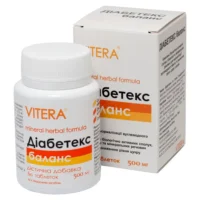Description
Amaril (Glimepiride) Tablets 2 mg. №30
Composition
Active ingredient: Glimepiride 2 mg.
Other ingredients: Lactose monohydrate, maize starch, povidone, and magnesium stearate.
Mechanism of Action
Glimepiride, a sulfonylurea, stimulates insulin release from pancreatic beta cells, leading to decreased blood glucose levels. It enhances insulin sensitivity in peripheral tissues, promoting glucose uptake.
Pharmacological Properties
Glimepiride, a sulfonylurea antidiabetic agent, acts by increasing insulin secretion from the pancreas and improving peripheral insulin sensitivity. These actions collectively result in reduced blood sugar levels and better utilization of glucose.
Indications for Use
Amaril tablets are indicated for the management of type 2 diabetes mellitus when dietary modifications, physical activity, and weight loss efforts are insufficient in controlling blood sugar levels.
Contraindications
Do not administer Amaril tablets to individuals with a known hypersensitivity to glimepiride or other sulfonylureas.
Side Effects
Common side effects of Amaril may include hypoglycemia, dizziness, and headache. Patients should be monitored for these adverse reactions during treatment.
Usage Instructions
Dosage: The typical initial dose is 1-2 mg taken once daily with breakfast or the first main meal. Adjustments to the dosage should be based on individual blood glucose readings.
Administration: Swallow the tablet whole with a glass of water. It is advisable to take the medication at the same time each day for optimal results.
Benefits Compared to Analogues
Amaril has demonstrated efficacy comparable to other sulfonylureas in managing type 2 diabetes mellitus. Its mechanism of action and safety profile make it a valuable option for patients requiring antidiabetic therapy.
Suitable Patient Groups
Amaril can be used in various patient populations, including adults, elderly individuals, and non-pregnant women with type 2 diabetes mellitus. Dosage adjustments may be necessary based on individual health status and renal function.
Storage and Shelf Life
Storage: Keep Amaril tablets at room temperature, protected from moisture and heat, to maintain their stability and efficacy.
Shelf Life: Check the packaging for the expiration date and do not use the product beyond this date.
Packaging Description
Amaril tablets are available in a pack containing 30 tablets of 2 mg strength. The packaging is designed to ensure product integrity and compliance with storage recommendations.
Clinical Evidence and Proven Effectiveness
Scientific Evidence: Clinical studies have shown that glimepiride effectively reduces blood glucose levels by stimulating insulin release from pancreatic beta cells. Research by Schernthaner G. et al. demonstrated the long-term efficacy and safety of glimepiride in type 2 diabetes management.
Clinical Trials: In a study by Marre M. et al., glimepiride exhibited comparable effectiveness to gliclazide in controlling blood glucose levels in patients with type 2 diabetes. The study highlighted the similar efficacy and safety profiles of glimepiride compared to other antidiabetic agents.





